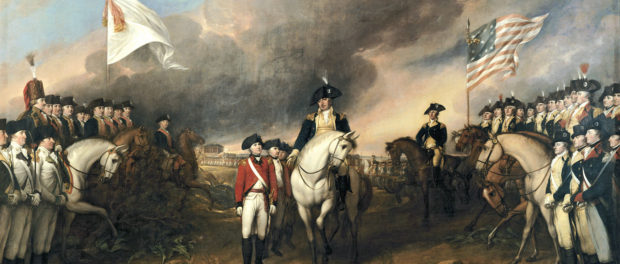Book of the Month Club: The Quartet by Joseph J. Ellis
 John Trumbull, "The Surrender of Lord Cornwallis", oil on canvas, 1820. Currently in the US Capitol, Washington DC.
John Trumbull, "The Surrender of Lord Cornwallis", oil on canvas, 1820. Currently in the US Capitol, Washington DC.
“One of the reasons Hamilton found the word democracy so offensive was because he realized that the vast majority of American citizens had not the dimmest understanding of what he was talking about.”
Perhaps a typical movie about the American Revolution would go like this: brave Patriots fight both the British army and the unbelievers (Loyalists), and the French join in maybe three quarters of the way through. The Patriots win 28-24, and it ends with George Washington being crowned, er, nominated President of the United States. And then the credits play the Star Spangled Banner and show the Statue of Liberty. But what if this traditional narrative wasn’t the case?
The Quartet with an interesting statement: the American Revolution from 1775 to 1783 was not about forming a country named America with a capital A. Rather, it was to become separate from the British empire–not exactly becoming a country. The Thirteen Colonies were at best a loose confederation of places immediately following the years after the revolution. Ellis’ bold proposition, and his thesis, is that the transition of America from this confederation to a united nation in the ten or so years after the revolution ended is due to four men: George Washington, Alexander Hamilton, John Jay, and James Madison.
Washington is at front and centre of the narrative: he is a man that cared about what happened to the colonies once the war ended. In order for his dream to become reality, he needed to tackle the financial problems America would have (i.e. they were practically broke), which was Alexander Hamilton’s job. Hamilton, a brave veteran of the Siege at Yorktown (generally considered the decisive American victory battle), was a shrewd bargainer and, with the help of some allies, used his military savvy to use the army (who were threatening mutiny in an already fragile independent place) to generate support for bigger tax collection to pay the nation’s debt. Jay, an aristocratic diplomat among men, was the negotiator during the Treaty of Paris that would grant Americans their right to independence and their territory. Finally, when America was still in political quasi-anarchy due to a general indifference among the former colonies as to governmental reform (not that there was much of a government to start with in the early days of independence), it was Madison’s job to revise the initial articles that entrenched the transitional governing system (the Articles of Confederation) into something a bit more centralised as to unite the former colonies into a country. Various historical figures familiar to popular culture, such as Benjamin Franklin and Thomas Jefferson pop in and out of the picture as the narrative goes on.
I particularly liked the analysis of Madison and Washington’s motives and psychology in their decisions leading up to and during the Philadelphia Convention that would draft a document which would become the American Constitution. Washington and his allies initially wanted a more centralised government rather than a government where its individual members can make their decisions, but in the end, they realised the need to compromise. I also liked that the author chose to include the individual would-be states’ dates of ratification of the articles destined to be constitutionalised with a vote on how many people voted for and against it. However, I would have liked a bit more primary sources: quotes to and from the four are rather sparse and I would have liked to read more in their own words how they wanted the government to be shaped, although this is more than compensated in the three appendices that allow the reader to compare and contrast the Articles of Confederation, the American Constitution, as well as their Bill of Rights. All in all, it is a good book and recommended for people who are already interested in American history, as this book does assume the reader has some general knowledge about the major figures and events of the war.





